Abstract
Aim: To describe plasma retinol values according to age, gender and pubertal maturation.
Type of study: Comparative, transverse and descriptive.
Place: Medellín, Colombia.
Subjects and methods: Plasma retinol values were determined in 588 boys and 531 girls aged between 6 and 18 y. For this, we used spectrophotometry by UV oxidation of retinol, results below 0.87 mmol/l were confirmed by high-performance liquid chromatography.
Results: Mean retinol plasma concentrations were slightly higher in girls under 10 y. However, above this age, values are generally higher in boys. Plasma retinol concentrations increased with pubertal maturation in both boys and girls in a statistically significant manner. The highest values were observed in girls with mammary development grades 3 and 4 (P<0.05) and in boys with external genitalia development grades 1 and 2 (P<0.05). Vitamin A deficiency based on plasma retinol concentration (<0.70 mmol/l), was observed in 3.6% of all individuals regardless of gender.
Conclusions: Plasma retinol concentration is correlated to pubertal maturation in both boys and girls. Vitamin A deficiency in school children and adolescents of Medellín is not a major health problem.
This is a preview of subscription content, access via your institution
Access options
Subscribe to this journal
Receive 12 print issues and online access
$259.00 per year
only $21.58 per issue
Buy this article
- Purchase on Springer Link
- Instant access to full article PDF
Prices may be subject to local taxes which are calculated during checkout
Similar content being viewed by others
References
Araújo CRC & Flores H (1978): Improved spectrophotometric vitamin A assay. Clin. Chem. 24, 386.
Babrin L & Babrin BJ (1992): The cost of successful adolescent growth and development in girls in relation to iron and vitamin A status. Am. J. Clin. Nutr. 55, 955–958.
Bessey OA (1946): The determination of vitamin A and carotene in small quantities of blood serum. J. Biol. Chem. 166, 177–188.
Botero JH, Montoya MN, Castaño A, Hurtado MI, Ocampo EN, Berrio M, Correa MC, López C, Muñoz AL, Cuellar P, Agudelo G & Cardona OL (2000): Prevalencia de anemia y parásitos, en escolares y adolescentes de la ciudad de Medellín. Infection 4, 1.
Brody T (1999): Nutritional Biochemistry, 2nd Edition, pp 554–564. San Diego: Academic.
Castro L & Nicholl S (1998): Deficiencia de vitamin A en niños entre 11 y 59 meses: deficiencia de hierro, vitamin A, y prevalencia de parasitismo intestinal en la población infantil y anemia nutricional en mujeres en edad fértil Colombia 1995–96, p 38. Santafé de Bogotá: Ministerio de Salud.
Dary O & Arroyave G (1996): Metodologías analíticas para control y evaluación de la fortificación de azúcar con vitamin A. Parte III. Determinación espectrofotométrica de retinol sanguíneo por destrucción UV del retinol y por HPLC. Guatemala: USAID, INCAP.
Dietz WH & Bellizzi M (1999): Introduction: the use of body mass index to assess obesity in children. Am. J. Clin. Nutr. 70 (Suppl), S123–S125.
Frazio-Tirrozzo GF, Brabin L, Brabin B, Agbaje O, Harper G & Broadhead R (1998): A community base study of vitamin A and vitamin E status of adolescent girls in Shire valley, Southern Malawi. Eur. J. Clin. Nutr. 52, 637–642.
Fu Z, Ohara S, Kato H, Sugahara K & Kubo T (1997): Retinoic acid accelerates the testicular maturation in Japanese quail. Anim. Sci. Tech. 68, 420–422.
Garry PJ, Hunt WC & Bandrofchak JL (1987): Vitamin A intake and plasma retinol levels in healthy men and women. Am. J. Clin. Nutr. 46, 989–994.
Groff JL, Gropper SS & Hunt SM (1995): Advanced Nutrition and Human Metabolism, 2nd Edition, p 299. Minneapolis: West.
Lithgow DM & Politzer WN (1977): Vitamin A in the treatment of menorrhagia. S. Afr. Med. J. 51, 191–193.
Lohman TG, Roche AF & Martorell R (1988): Antropometric Standardization Reference Manual. Champaign: Human Kinetics Books.
Mahan LK & Scott-Stumps S (1999): Krause's Food Nutrition and Diet Therapy, 9th Edition, p 75. Philadelphia: Saunders.
Marshall WA (1978): Puberty. In: Human Growth, eds F Falkner & JM Tanner, pp 141–148. New York: Plenum Press.
Must AG & William H (1991). Reference data for obesity: 85th and 95th percentiles of body mass index (wt/Ht (2)) — a correction. Am. J. Clin. Nutr. 53, 773.
Ncube TN, Malaba L, Griner T & Gebre-Medhim M (2001): Evidence of grave vitamin A deficiency among lactating women in the semi-arid rural area of Makhaza in Zimbabwe. A population-based study. Eur. J. Clin. Nutr. 55, 229–234.
Noy N (2000): Vitamin A. In: Biochemical and Physiological Aspects of Human Nutrition, ed. MH Stipanuk, pp 599–623. Philadelphia: Saunders.
Olmedilla B & Granado F (2000): Growth and micronutrient needs of adolescents. Eur. J. Clin. Nutr. 54 (Suppl 1), S11–S15.
Olson JA (1991): Vitamin A. In: Conocimientos actuales sobre nutrición, 6th Edition, p 117. Washington: OPS, ILSI.
Restrepo MT (2000): Estado nutricional y crecimiento físico. Medellín: editorial Universidad de Antioquia.
Ross SA & De Luca LM (1996): A new metabolite of retinol; all-trans-4-0x0-retinol as a receptor activator and differentiation agent. Nutr. Rev. 54, 355–356.
Ross AC & Stephesen CB (1996): Vitamin A and retinoids in antiviral response. FASEB J. 10, 978–985.
Tanner JM (1978): Foetus into Man Physical Growth from Conception to Maturity. Cambridge: Harvard University Press.
Vahlquiest A, Johnson A & Nigren KG (1979) Vitamin A transporting plasma proteins and female sex hormones. Am. J. Clin. Nutr. 32, 1433–1438.
Van den Berg H (1996): Vitamin A intake and status. Eur. J. Clin. Nutr. 50 (Suppl 3), S7–S12.
Author information
Authors and Affiliations
Contributions
Guarantor: MC Álvarez Uribe.
Contributors: MCA and RMU participated in the design, the recollection of data, analysis, and the ellaboration of the paper. CL, CMB, LC and VN processed the biochemical sample and they participated in the analysis and the ellaboration of the paper.
Corresponding author
Rights and permissions
About this article
Cite this article
Álvarez Uribe, M., Uscátegui Peñuela, R., López Bedoya, C. et al. Plasma retinol concentration according to pubertal maturation in school children and adolescents of Medellín, Colombia. Eur J Clin Nutr 58, 456–461 (2004). https://doi.org/10.1038/sj.ejcn.1601828
Received:
Revised:
Accepted:
Published:
Issue Date:
DOI: https://doi.org/10.1038/sj.ejcn.1601828
Keywords
This article is cited by
-
Prevalence of vitamin A deficiency and dietary inadequacy in Indian school-age children and adolescents
European Journal of Nutrition (2022)
-
Vitamin A deficiency among Brazilian school-aged children in a healthy child service
European Journal of Clinical Nutrition (2009)



